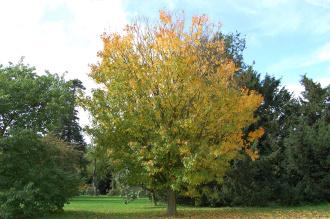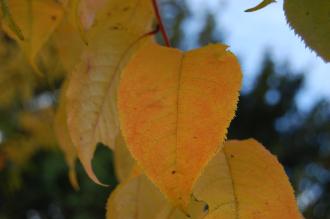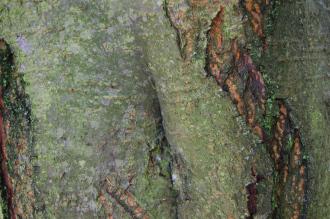
Prunus grayana (21/10/2013, Kew Gardens, London)
Position: Full sun to partial shade
Flowering period: Spring
Soil: Moist, well drained
Eventual Height: 10m
Eventual Spread: 10m
Hardiness: 6a, 6b, 7a, 7b, 8a, 8b, 9a
Family: Rosaceae
Prunus grayana is a deciduous tree with a rounded habit. Its mid green leaves are elliptic to ovoid with serrate margins, up to 10cm long and 4cm broad. Its leaves turn yellow/ orange before they fall in autumn. Its gray bark is smooth with horizontal brown lenticels. Its white flowers are up to 8mm across and are produced on racemes which are up to 8cm long and appear after the leaves. Its black fruit is a drupe and up to 8mm across.

Prunus grayana Autumn Leaf (21/10/2013, Kew Gardens, London)
Prunus grayana, is commonly known as Japanese Bird Cherry or Grey’s Bird Cherry, is native to Japan and east and south China. In its native habitat it grows in forest valleys. Prunus grayana is synonymous with Padus grayana.
The etymological root of the binomial name Prunus is from the classical name of the Plum tree. Grayana is named after Asa Gray (1810 – 1888), and American botanist.
The landscape architect may find Prunus grayana useful as an attractive spring flowering tree with edible fruit and attractive autumn leaves.
Ecologically, Prunus grayana flowers are attractive to pollinating insects. Its fruit are attractive to birds and mammals.

Prunus grayana Bark (21/10/2013, Kew Gardens, London)
Prunus grayana prefers moist, fertile, well-drained soils. It tolerates most pH of soil.
Prunus grayana requires little maintenance. Pruning should be carried out after flowering, from April to July to minimise the risk of Silver leaf infection.

